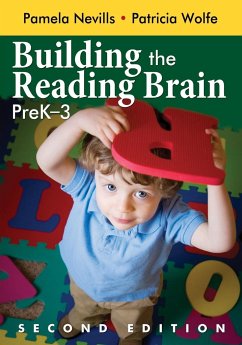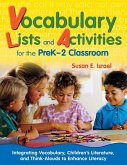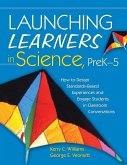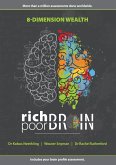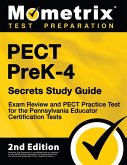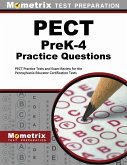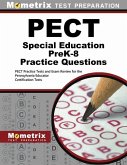- Broschiertes Buch
- Merkliste
- Auf die Merkliste
- Bewerten Bewerten
- Teilen
- Produkt teilen
- Produkterinnerung
- Produkterinnerung
Discover how children's brains change as they develop early reading skills! Moving through skills acquisition from birth to age eight, this updated edition of the best-selling book gives educators a clear picture of how children acquire and develop language skills in preparation for reading. This updated edition features developmentally appropriate practices for fostering critical literacy skills in each age group and expanded information on English learners and Response to Intervention. The authors provide: Brain-friendly strategies that build phonemic awareness, phonics, vocabulary,…mehr
Andere Kunden interessierten sich auch für
![Vocabulary Lists and Activities for the PreK-2 Classroom Vocabulary Lists and Activities for the PreK-2 Classroom]() Susan E. IsraelVocabulary Lists and Activities for the PreK-2 Classroom40,99 €
Susan E. IsraelVocabulary Lists and Activities for the PreK-2 Classroom40,99 €![Launching Learners in Science, PreK-5 Launching Learners in Science, PreK-5]() Kerry C. WilliamsLaunching Learners in Science, PreK-542,99 €
Kerry C. WilliamsLaunching Learners in Science, PreK-542,99 €![Rich Brain, Poor Brain Rich Brain, Poor Brain]() Kobus NeethlingRich Brain, Poor Brain17,99 €
Kobus NeethlingRich Brain, Poor Brain17,99 €![Pect Prek-4 Secrets Study Guide - Exam Review and Pect Practice Test for the Pennsylvania Educator Certification Tests Pect Prek-4 Secrets Study Guide - Exam Review and Pect Practice Test for the Pennsylvania Educator Certification Tests]() Pect Prek-4 Secrets Study Guide - Exam Review and Pect Practice Test for the Pennsylvania Educator Certification Tests61,99 €
Pect Prek-4 Secrets Study Guide - Exam Review and Pect Practice Test for the Pennsylvania Educator Certification Tests61,99 €![Pect Prek-4 Practice Questions Pect Prek-4 Practice Questions]() Pect Prek-4 Practice Questions35,99 €
Pect Prek-4 Practice Questions35,99 €![Pect Special Education Prek-8 Practice Questions Pect Special Education Prek-8 Practice Questions]() Pect Special Education Prek-8 Practice Questions35,99 €
Pect Special Education Prek-8 Practice Questions35,99 €![PRAXIS Principles of Learning and Teaching: Prek-12 (5625) Secrets Study Guide PRAXIS Principles of Learning and Teaching: Prek-12 (5625) Secrets Study Guide]() PRAXIS Principles of Learning and Teaching: Prek-12 (5625) Secrets Study Guide36,99 €
PRAXIS Principles of Learning and Teaching: Prek-12 (5625) Secrets Study Guide36,99 €-
-
-
Discover how children's brains change as they develop early reading skills! Moving through skills acquisition from birth to age eight, this updated edition of the best-selling book gives educators a clear picture of how children acquire and develop language skills in preparation for reading. This updated edition features developmentally appropriate practices for fostering critical literacy skills in each age group and expanded information on English learners and Response to Intervention. The authors provide: Brain-friendly strategies that build phonemic awareness, phonics, vocabulary, comprehension, and fluency skills Instructional applications for games, music, and play Interventions for children with early reading difficulties
Hinweis: Dieser Artikel kann nur an eine deutsche Lieferadresse ausgeliefert werden.
Hinweis: Dieser Artikel kann nur an eine deutsche Lieferadresse ausgeliefert werden.
Produktdetails
- Produktdetails
- Verlag: Corwin
- 2. Auflage
- Seitenzahl: 232
- Erscheinungstermin: 6. Januar 2009
- Englisch
- Abmessung: 254mm x 178mm x 13mm
- Gewicht: 445g
- ISBN-13: 9781412963268
- ISBN-10: 1412963265
- Artikelnr.: 25435584
- Herstellerkennzeichnung
- Libri GmbH
- Europaallee 1
- 36244 Bad Hersfeld
- gpsr@libri.de
- Verlag: Corwin
- 2. Auflage
- Seitenzahl: 232
- Erscheinungstermin: 6. Januar 2009
- Englisch
- Abmessung: 254mm x 178mm x 13mm
- Gewicht: 445g
- ISBN-13: 9781412963268
- ISBN-10: 1412963265
- Artikelnr.: 25435584
- Herstellerkennzeichnung
- Libri GmbH
- Europaallee 1
- 36244 Bad Hersfeld
- gpsr@libri.de
Pamela Nevills is first and foremost a teacher, working with learners from multiages-primary grades through post graduate students. She supervises student teachers and teaches methods classes at the University of California, Riverside. She has participated on and has been honored by local and state advisory committees. As a two-time panel member for reading textbook selection for the state of California, she is well versed with state and national content standards. She is a national and international speaker and consultant on topics that include brain development from birth through adulthood, the brain and reading, school designs for all readers, and adult learners. Writing is a recent addition to Nevills's work. She is published through the state of California and by the Journal of Staff Development, and she regularly contributes to organizational newsletters. Her passion for reading and the brain developed from a childhood love affair with books and encouragement from a dear friend, Pat Wolfe. Nevills can be reached at 1619 Tecalote Drive, Fallbrook, CA 92028; phone (760) 723-8116; e-mail address: .
Acknowledgments About the Authors Introduction 1. On the Nature of Reading The Importance of Learning to Read Why Learning to Read Is So Difficult The Basics of Reading Reflective Questions 2. What Happens in the Brain When Children Read Words? Brain Basics Reading Problems With a Biological Basis Attention and Memory Systems Reflective Questions 3. Building a Foundation for Reading: Birth to Age 3 Reading Relies on Early Language Skills The Beginnings of Language The Language Explosion: 1 to 2 Years Precursors to Writing in the First 3 Years Reflective Questions 4. Emerging Literacy During the Preschool Years Mirror Neurons Drive Learning Oral Language and Vocabulary Print Awareness and Alphabet Developing Writing Skills Reflective Questions 5. Beginning to Read: Ages 5 and 6 Instruction Essentials for Emerging Readers The Brain
s Memory Systems Breaking Away From Static Teaching Tradition Priming Skills for 5- and 6-Year-Olds Reflective Questions 6. Breaking the Reading Code: Learning to Read Through Instruction Reading and Language Arts Guidelines for Kindergarten and First Grade Structuring the Brain for Decoding Word Recognition Gains Sophistication Teaching Encoding: Spelling and Writing Reading Beyond Encoding and Decoding Reflective Questions 7. Assessing and Responding to Readers at Risk The Case for Early Assessment English Language Learners Assessments of Students With Regularly Developing Reading Skills Differences in Brain Development Assessment and Reading Standards Response to Intervention: Reading Models School Interventions That Work Reflective Questions 8. Comprehension and Vocabulary: Challenges for Second Grade Reading and Language Arts Guidelines for Second Grade Instruction for Vocabulary and Comprehension Ways to Teach the Curious Brain Building the Brain for Comprehension Strategic Reading With Comprehension in Mind Reflective Questions 9. Putting Reading Skills to the Task: Expectations for Third Grade and Beyond Reading and Language Arts Guidelines for Third Grade Factors Affecting Reading Fluency The Brain
s Rate of Processing Developing Reading Fluency Final Comments Reflective Questions 10. Conclusion A Child
s Brain and Reading: A Dozen Key Learnings Glossary Instructional Resources References and Further Reading Index
s Memory Systems Breaking Away From Static Teaching Tradition Priming Skills for 5- and 6-Year-Olds Reflective Questions 6. Breaking the Reading Code: Learning to Read Through Instruction Reading and Language Arts Guidelines for Kindergarten and First Grade Structuring the Brain for Decoding Word Recognition Gains Sophistication Teaching Encoding: Spelling and Writing Reading Beyond Encoding and Decoding Reflective Questions 7. Assessing and Responding to Readers at Risk The Case for Early Assessment English Language Learners Assessments of Students With Regularly Developing Reading Skills Differences in Brain Development Assessment and Reading Standards Response to Intervention: Reading Models School Interventions That Work Reflective Questions 8. Comprehension and Vocabulary: Challenges for Second Grade Reading and Language Arts Guidelines for Second Grade Instruction for Vocabulary and Comprehension Ways to Teach the Curious Brain Building the Brain for Comprehension Strategic Reading With Comprehension in Mind Reflective Questions 9. Putting Reading Skills to the Task: Expectations for Third Grade and Beyond Reading and Language Arts Guidelines for Third Grade Factors Affecting Reading Fluency The Brain
s Rate of Processing Developing Reading Fluency Final Comments Reflective Questions 10. Conclusion A Child
s Brain and Reading: A Dozen Key Learnings Glossary Instructional Resources References and Further Reading Index
Acknowledgments About the Authors Introduction 1. On the Nature of Reading The Importance of Learning to Read Why Learning to Read Is So Difficult The Basics of Reading Reflective Questions 2. What Happens in the Brain When Children Read Words? Brain Basics Reading Problems With a Biological Basis Attention and Memory Systems Reflective Questions 3. Building a Foundation for Reading: Birth to Age 3 Reading Relies on Early Language Skills The Beginnings of Language The Language Explosion: 1 to 2 Years Precursors to Writing in the First 3 Years Reflective Questions 4. Emerging Literacy During the Preschool Years Mirror Neurons Drive Learning Oral Language and Vocabulary Print Awareness and Alphabet Developing Writing Skills Reflective Questions 5. Beginning to Read: Ages 5 and 6 Instruction Essentials for Emerging Readers The Brain
s Memory Systems Breaking Away From Static Teaching Tradition Priming Skills for 5- and 6-Year-Olds Reflective Questions 6. Breaking the Reading Code: Learning to Read Through Instruction Reading and Language Arts Guidelines for Kindergarten and First Grade Structuring the Brain for Decoding Word Recognition Gains Sophistication Teaching Encoding: Spelling and Writing Reading Beyond Encoding and Decoding Reflective Questions 7. Assessing and Responding to Readers at Risk The Case for Early Assessment English Language Learners Assessments of Students With Regularly Developing Reading Skills Differences in Brain Development Assessment and Reading Standards Response to Intervention: Reading Models School Interventions That Work Reflective Questions 8. Comprehension and Vocabulary: Challenges for Second Grade Reading and Language Arts Guidelines for Second Grade Instruction for Vocabulary and Comprehension Ways to Teach the Curious Brain Building the Brain for Comprehension Strategic Reading With Comprehension in Mind Reflective Questions 9. Putting Reading Skills to the Task: Expectations for Third Grade and Beyond Reading and Language Arts Guidelines for Third Grade Factors Affecting Reading Fluency The Brain
s Rate of Processing Developing Reading Fluency Final Comments Reflective Questions 10. Conclusion A Child
s Brain and Reading: A Dozen Key Learnings Glossary Instructional Resources References and Further Reading Index
s Memory Systems Breaking Away From Static Teaching Tradition Priming Skills for 5- and 6-Year-Olds Reflective Questions 6. Breaking the Reading Code: Learning to Read Through Instruction Reading and Language Arts Guidelines for Kindergarten and First Grade Structuring the Brain for Decoding Word Recognition Gains Sophistication Teaching Encoding: Spelling and Writing Reading Beyond Encoding and Decoding Reflective Questions 7. Assessing and Responding to Readers at Risk The Case for Early Assessment English Language Learners Assessments of Students With Regularly Developing Reading Skills Differences in Brain Development Assessment and Reading Standards Response to Intervention: Reading Models School Interventions That Work Reflective Questions 8. Comprehension and Vocabulary: Challenges for Second Grade Reading and Language Arts Guidelines for Second Grade Instruction for Vocabulary and Comprehension Ways to Teach the Curious Brain Building the Brain for Comprehension Strategic Reading With Comprehension in Mind Reflective Questions 9. Putting Reading Skills to the Task: Expectations for Third Grade and Beyond Reading and Language Arts Guidelines for Third Grade Factors Affecting Reading Fluency The Brain
s Rate of Processing Developing Reading Fluency Final Comments Reflective Questions 10. Conclusion A Child
s Brain and Reading: A Dozen Key Learnings Glossary Instructional Resources References and Further Reading Index

